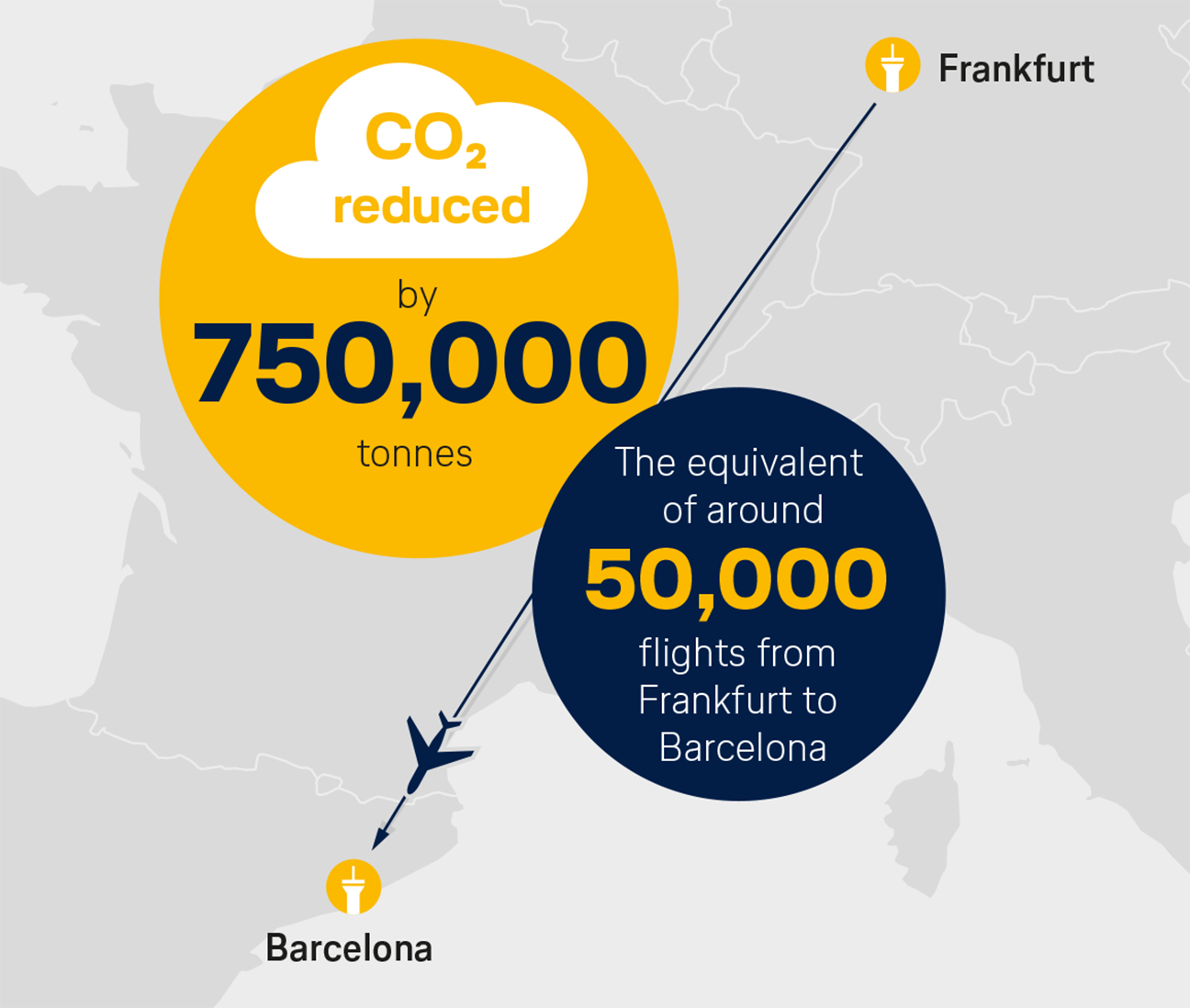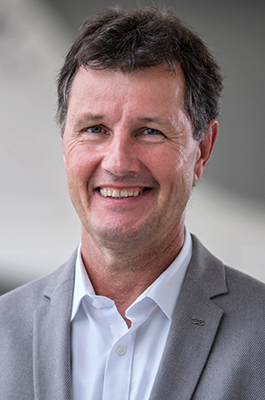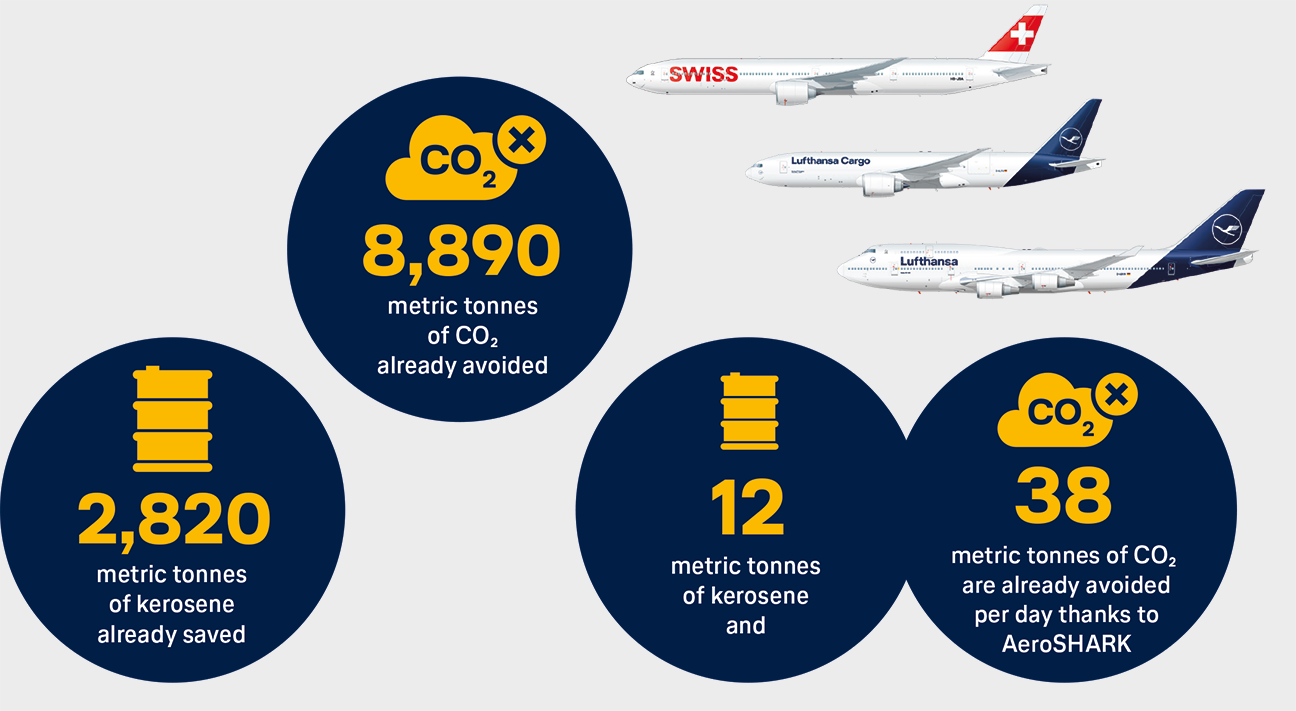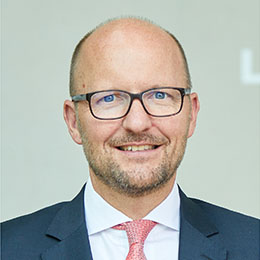| | | | Policy BriefSeptember 2023 | |
| | | | Dear Readers, The use of modern aircraft is the most effective lever for reducing the climate impact of aviation. This is because each new model consumes up to 30 percent less kerosene than its predecessor and reduces CO2 emissions accordingly. As part of the largest fleet modernization program in the company’s history, the Lufthansa Group will receive 200 new aircraft by 2030, a new aircraft every ten days on average. Nevertheless, it’s not only the aircraft models that make a difference: in order to fly in the most climate-friendly way possible, airspace must be used with maximum efficiency. Thanks to a new technology that optimizes flight routes, we can avoid detours and reduce CO2 emissions. The Lufthansa Group is already implementing this new system, which will become mandatory in the European Union starting in 2028. Another innovation for climate protection in aviation is the AeroSHARK surface technology developed by Lufthansa Technik and BASF, inspired by the skin of sharks, which effectively reduces drag. The Lufthansa Group is the world’s first airline group to operate long-haul aircraft equipped with this coating. Furthermore, attention is increasingly focusing on the non-CO2 effects of aviation. In a guest article, the German Aerospace Center (DLR) sheds light on the current state of the scientific understanding and explains how the DLR and Lufthansa are working together to research and mitigate these effects. We also turn our attention to our neighboring country France. Despite the French government’s implementation of a domestic flight ban, it is interesting to note that there are still more domestic flights in France than in Germany. The reasons behind this are explained in detail in this policy brief. Finally, we have an important announcement for attendees of the UN Climate Change Conference COP28 in Dubai. Lufthansa Group Airlines are offering travelers from Germany, Austria, Switzerland, and Belgium a special rate that allows them to offset 100 percent of their flight-related CO2 emissions via SAF. We wish you an enjoyable reading experience! Andreas Bartels
Head of Communications
Lufthansa Group | Dr. Kay Lindemann
Head of Corporate International
Relations and Government Affairs
Lufthansa Group
|
| |
| | | | Optimized flight routesNEW TECHNOLOGY REDUCES CO2 EMISSIONSStarting in 2024, the Lufthansa Group will equip its fleet with an innovative flight route technology to avoid flight diversions and, consequently, reducing CO2 emissions. Four years later, the technology is to become mandatory in Europe. The EU Commission is called upon to adhere to its schedule in a binding manner. | |
| | | | Flight route technology offers huge potential
The ADS-C EPP technology will be binding across Europe starting from 2028. The annual savings potential for European airlines: 
| |
| | | | In addition to the use of fuel-efficient aircraft and sustainable fuels, modern airspace management plays a crucial role in achieving environmentally friendly aviation. The “Automatic Dependent Surveillance – Contract Extended Projected Profile” (ADS-C EPP) continuously transmits real-time flight data to the ground, enabling continuous adjustments to the current flight route Making more efficient and sustainable use of airspace
With the assistance of this application, which creates a 4D flight path in spatial dimensions (length, width, height) and time, flight information is transmitted automatically and in real time to air traffic control. The generated data is extremely precise, facilitating more efficient airspace management. Air traffic controllers can continuously determine optimally coordinated flight routes for all aircraft equipped with the technology, thereby enhancing airspace capacities. This approach minimizes diversions, leading to reduced kerosene consumption and lower CO2 emissions. In figures, this translates to each equipped aircraft saving up to 80 tonnes of CO2 per year. For European airlines, this represents a potential reduction of around 750,000 tonnes of CO2 annually – equivalent to nearly 50,000 flights from Frankfurt to Barcelona. ADS-C EPP also optimizes takeoffs and landings: in a traditional step-by-step ascent, aircraft reach their desired flying altitude through individual steps, which consumes more fuel and requires air traffic controllers to provide instructions at each step. On ascents optimized by ADS-C EPP, aircraft can ascend continuously in a fuel-efficient manner. Additionally, this technology reduces CO2 emissions during landings by enabling aircraft to fly for longer at their optimal cruising altitude, where fuel consumption is lower. Investments require planning certainty
To realize full CO2 saving potential, all airlines and air traffic control will need to adopt the new technology in the future. However, airlines will only invest in this technological equipment if Brussels adheres to the agreed implementation timeline starting from 2028. Therefore, it is crucial for the EU Commission to pursue the established schedule in a clear and binding manner, and to offer significant incentives for investments right away. | |
| | | | Lufthansa Group takes on a pioneering role
Starting from 2028, the new ADS-C EPP flight data technology is to become mandatory for all new aircraft and air traffic control ground systems. The Lufthansa Group will begin using this technology as early as next year to expedite CO2 savings on its flights. To achieve this goal, over 65 Airbus A320neo and A321neo aircraft will be equipped with this system starting in 2024. | |
| | | | French “domestic flight ban”A ROLE MODEL?Domestic flights have become a controversial topic in climate policy discussions, with comparison often being drawn with France and its introduction of a “domestic flight ban." It is true that restrictions on domestic flights have been in place in our neighboring country since May 2023. Nevertheless, it may surprise that the number of weekly domestic flights in France stands at a total of 4,200, almost twice as high as in Germany. How can this discrepancy be explained? | |
| | | | Comparison of weekly domestic flights in 2023 
| |
| | | | In France, a strict rule applies: if two cities can be reached by train multiple times a day within a maximum travel time of two and a half hours, flights are prohibited. While this might sound stringent, there are nuances to consider. First, France’s central hub airport Paris-Charles de Gaulle (CDG) remains unaffected by these regulations. The train cannot compete with any flight route to CDG airport within a 2.5 hour time frame. This time window allows the French government to safeguard its strong hub and network airline operating there. Secondly, even beyond the hub, the impact is manageable. Despite discontinuing flights between Paris-Orly and Bordeaux, Nantes and Lyon in preparation for May 2023, little has changed since then. The resulting reduction in CO2 emissions is approximately 0.2 percent of all air traffic emissions in France. This figure only holds true if the trip is cancelled entirely and not replaced by car or train travel. Thirdly, even with an improved rail service, these restrictions will only affect a few domestic routes. If France’s regulations were applied directly to Germany, it would impact only four routes. The effect, as in France, would be marginal. | |
| | | | Why is France protecting Paris-Charles de Gaulle?
Hubs are essential to ensuring international connectivity, because long-haul flights do not solely carry passengers from the immediate airport catchment area. They also serve as central gathering points for travelers from various domestic and foreign cities. The French government is well aware of this fact and has strategically designed domestic air traffic restrictions in France in such a way that Paris-Charles de Gaulle remains unaffected. | |
| | | | Ultimately, the French regulations are symbolic policy. So, what would be a better approach? The answer lies in consistently optimizing synergies between rail and air traffic, a concept that works well in Germany even without legal requirements. Lufthansa and Deutsche Bahn are continuously expanding their cooperation, ensuring there is now an alternative train connection for every domestic feeder flight to and from Frankfurt. Flight routes with attractive rail services have long been discontinued, for example routes such as Hamburg-Berlin, Berlin-Nuremberg, and Cologne-Frankfurt. It is essential to note that most domestic flights are merely the first leg of an international journey. Passengers flying with Lufthansa from Stuttgart to Frankfurt, for instance, usually intend to transfer at the hub to reach destinations in the Far East, Africa, or America. The goal is to persuade these travelers to embrace intermodal services. However, government involvement is crucial. To date, only five German airports are connected to the long-distance rail network: Frankfurt, Dusseldorf, Berlin, Cologne-Bonn, and Leipzig-Halle. Stuttgart is scheduled to follow in 2025, while Munich still lags behind. One thing is clear: the more highspeed lines there are, connecting airports with cities throughout Germany, the fewer domestic flights there will be. | |
| | | | Structure of German domestic flights
● Domestic passengers on routes <400 km: 3%
● Proportion of transfers: 2/3
● Development of domestic air traffic vs. 2019: -53% | |
| | | | Guest articleREDUCING NON-CO2 EFFECTS TOGETHERAviation also contributes to climate change through non-CO2 effects. The main causes are contrails and cirrus clouds that contribute to atmospheric warming. DLR and Lufthansa are jointly driving research and efforts to address these non-CO2 effects. | |
| | | | Global aviation accounts for around 3.5 percent of humaninduced global warming, with a significant portion attributed to non-CO2 effects. To better understand these impacts and develop measures to mitigate their climate effects, Lufthansa and DLR are working closely together. One notable initiative is the CARIBIC flying measurement laboratory, which is installed in the cargo hold of a Lufthansa aircraft and gathers data during regular flights. Lufthansa is also actively involved in the EU research project IAGOS, operating three long-haul aircraft as part of the project. Flying around regions
Non-CO2 effects can be significantly reduced through technical measures, especially through the use of sustainable aviation fuels (SAF). Another option involves altering flight paths to circumvent regions where the climate-changing contrails and cirrus clouds tend to form. These phenomena only occur in specific areas characterized by extremely cold temperatures and high humidity at cruising altitudes. According to current research, only a small percentage of all flights operating in these regions worldwide are affected. The challenge lies in predicting these regions as accurately as possible on a daily basis, using weather data and forecasting models such as those provided by the DLR. Although precise forecasting, especially with respect to humidity, remains challenging, it is feasible to make significant contributions to climate protection in global aviation through relatively minor adjustments. However, planning, implementing, and evaluating climate-compatible flight routes within regular flight operations requires extensive research and development. Collaboration between politics, science, and industry is essential in this endeavour. Lufthansa as a partner in the lighthouse project
The D-KULT (Demonstrator Climate and Environmentally Friendly Air Transport) project, funded in 2022 by the German government's aeronautical research program, is a flagship initiative. Led by the DLR, the project aims to determine climate-optimized flight routes and to seamlessly incorporate them into operational procedures. Lufthansa is a partner in this endeavor, conducting measurement flights (scheduled flights) to validate forecast data and flight planning software for avoiding regions that affect the climate. The project’s progress is monitored by satellite observations. EU: Reviewing climate impacts
Non-CO2 effects are also shifting into the spotlight at the European level. In May 2023, the EU decided to incorporate a reporting and verification system (MRV) for non-CO2 effects to emissions trading (ETS) by the middle of next year. The objective is to gain a reliable understanding of the climate impact of individual flights through the collection and analysis of more data. Airlines will have to comply with this new reporting requirement as early as 2025. The EU Commission plans to conduct an impact assessment by 2027 and issue regulations if deemed necessary. Targeting non-CO2 effects
The DLR is currently supporting the EU in establishing this MRV system, emphasizing the need for effective regulatory incentives to identify relevant flights and thereby reduce their climate impact. One-size-fits-all approaches are not helpful in this context. Unlike previous CO2 regulations in Europe, measures to mitigate non-CO2 effects should be reinforced in a targeted manner. Important components include supporting the rapid ramp-up and use of SAF and modern flight route optimization systems. The focus should be on practical and pragmatic implementation for flight operations. Our commitment centers around achieving climate-compatible aviation. A high degree of robustness and accuracy in avoiding climate-affecting contrails will make a significant contribution. To achieve this, we need partners who will continue to work with us, just as we are already taking significant steps together with Lufthansa. | |
| | | | 
DR.-ING. MARKUS FISCHER
DLR Director Aeronautics | |
| | | | UN World Climate ConferenceSpecial fare with SAF for flights to DubaiAt the end of November, the UN Climate Change Conference, COP28, will start in Dubai, with thousands of participants from around the world expected to join. To promote climatefriendly mobility, the Lufthansa Group is presenting an especially sustainable package of services. Travelers from Germany, Austria, Switzerland, and Belgium can benefit from a special fare that offsets 100 percent of flightrelated CO2 emissions through sustainable aviation fuel (SAF). In addition, this offer includes a free rebooking option and a bicycle voucher that can be used for a week in Dubai and Abu Dhabi. Business Class guests can further take advantage of an airport-to-hotel transfer by e-limousine. This special fare is available across all booking classes and can be booked on the Lufthansa website until December 10. | |
| | | | AeroSHARKMORE AND MORE AIRCRAFT WITH “SHARK SKIN”AeroSHARK, a surface structure jointly developed by Lufthansa Technik and BASF, is a successful project for enhancing climate protection in aviation: it reduces friction, and thus the aircraft drag, thereby cutting fuel consumption by approximately one percent. Notably, the Lufthansa Group is the world’s first airline group to equip over 20 aircraft with this innovative technology. To date, 14 long-haul aircraft operated by Lufthansa, SWISS, and Lufthansa Cargo, have undergone modifications, each featuring several hundred square meters of the riblet film. | |
| | | | Climate protection with AeroSHARK in figures 
| |
| | | | LUFTHANSA GROUPYOUR CONTACTS Show PDF Show PDF

Andreas Bartels
Head of Corporate Communications
Lufthansa Group  +49 69 696-3659 +49 69 696-3659
 andreas.bartels@dlh.de andreas.bartels@dlh.de
| 
Dr. Kay Lindemann
Head of Corporate International Relations
and Government Affairs
Lufthansa Group  +49 30 8875-3030 +49 30 8875-3030
 kay.lindemann@dlh.de kay.lindemann@dlh.de
|

Martin Leutke
Head of Communications
Lufthansa Group  +49 69 696-36867 +49 69 696-36867
 martin.leutke@dlh.de martin.leutke@dlh.de
| 
Jan Körner
Head of Government Affairs Germany
and Eastern Europe
Lufthansa Group  +49 30 8875-3212 +49 30 8875-3212
 jan.koerner@dlh.de jan.koerner@dlh.de
|

Sandra Courant
Head of Political Communication
and Media Relations Berlin
Lufthansa Group  +49 30 8875-3300 +49 30 8875-3300
 sandra.courant@dlh.de sandra.courant@dlh.de
| 
Jörg Meinke
Head of EU Liaison Office
Lufthansa Group  +32 492 228141 +32 492 228141
 joerg.meinke@dlh.de joerg.meinke@dlh.de
|
| |
| | | | Published by:
Deutsche Lufthansa AG
FRA CI,
Lufthansa Aviation Center
Airportring, D-60546 Frankfurt Andreas Bartels
Head of Communications
Lufthansa Group Dr. Kay Lindemann
Head of Corporate International
Relations and Government Affairs
Lufthansa Group Martin Leutke
Head of Communications
Lufthansa Group | Editor in Chief:
Sandra Courant
Head of Political Communication
and Media Relations Berlin
Lufthansa Group Editorial Staff:
Markus Karassek, Heidi Kiser, Alexander Lutz, Steffen von Eicke, Franziska Feinig Press date:
27 September 2023 Agency Partners:
Köster Kommunikation
GDE | Kommunikation gestalten |
| |
|